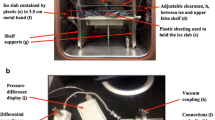Abstract
The flow physics in the product chamber of a freeze dryer involves coupled heat and mass transfer at different length and time scales. The low-pressure environment and the relatively small flow velocities make it difficult to quantify the flow structure experimentally. The current work presents the three-dimensional computational fluid dynamics (CFD) modeling for vapor flow in a laboratory scale freeze dryer validated with experimental data and theory. The model accounts for the presence of a non-condensable gas such as nitrogen or air using a continuum multi-species model. The flow structure at different sublimation rates, chamber pressures, and shelf-gaps are systematically investigated. Emphasis has been placed on accurately predicting the pressure variation across the subliming front. At a chamber set pressure of 115 mtorr and a sublimation rate of 1.3 kg/h/m2, the pressure variation reaches about 9 mtorr. The pressure variation increased linearly with sublimation rate in the range of 0.5 to 1.3 kg/h/m2. The dependence of pressure variation on the shelf-gap was also studied both computationally and experimentally. The CFD modeling results are found to agree within 10% with the experimental measurements. The computational model was also compared to analytical solution valid for small shelf-gaps. Thus, the current work presents validation study motivating broader use of CFD in optimizing freeze-drying process and equipment design.














Similar content being viewed by others
References
Alexeenko AA, Ganguly A, Nail SL. Computational analysis of fluid dynamics in pharmaceutical freeze-drying. J Pharmaceut Sci. 2009;98(9):3483–94.
Rasetto V, Marchisio DL, Fissore D, Barresi AA (2010). On the use of a dual-scale model to improve understanding of a pharmaceutical freeze-drying process. J Pharmaceut Sci. 2010;99(10):4337–50.
Ganguly A, Nail SL, Alexeenko AA. Rarefied gas dynamics aspects of pharmaceutical freeze-drying. Vacuum. 2012;86(11):1739–47.
Petitti M, Barresi AA, Marchisio DL. CFD modelling of condensers for freeze-drying processes. Sadhana. 2013;38(6):1219–39.
Sheehan P, Liapis AI. Modeling of the primary and secondary drying stages of the freeze drying of pharmaceutical products in vials: numerical results obtained from the solution of a dynamic and spatially multi-dimensional lyophilization model for different operational policies. Biotechnol Bioeng. 1998;60(6).
Mascarenhas W, Akay H, Pikal M. A computational model for finite element analysis of the freeze-drying process. Comput Methods Appl Mech Eng. 1997;148(1).
Song C, Nam J, Kim C, Ro S. A finite volume analysis of vacuum freeze drying processes of skim milk solution in trays and vials. Dry Technol. 2002;20(2).
Nakagawa K, Hottot A, Vessot S, Andrieu J (2007). Modeling of freezing step during freeze-drying of drugs in vials. AIChE J. 2007;53(5).
Sharma C, Malhotra D, Rathore A. Review of computational fluid dynamics applications in biotechnology processes. Biotechnol Progress. 2011;27(6).
Pikal M, Shah S, Senior D, Lang J. Physical chemistry of freeze-drying: measurement of sublimation rates for frozen aqueous solutions by a microbalance technique. J Pharmaceut Sci. 1983, 72(6):635–50.
Fluent A. (n.d.). 12.0 Theory Guide. Ansys Inc.
Zhang S, Liu J. Distribution of vapor pressure in the vacuum freeze-drying equipment. Math Problems Eng. 2012;2012.
Sane P, Varma N, Ganguly A, Pikal M, Alexeenko A, Bogner RH et al. Spatial variation of pressure in the lyophilization product chamber part 2: experimental measurements and implications for scale-up and batch uniformity. AAPS PharmSciTech. 2016, accepted for publication.
Hottot A, Andrieu J, Hoang V, Shalaev EY, Gatlin LA, Ricketts S. Experimental study and modeling of freeze-drying in syringe configuration. part II: mass and heat transfer parameters and sublimation end-points. Dry Technol. 2009;27(1):49–58.
Patel S, Doen T, Pikal MJ. Determination of end point of primary drying in freeze-drying process control. AAPS PharmSciTech. 2010;11(1).
Patel SM, Chaudhuri S, Pikal MJ. Choked flow and importance of Mach I in freeze-drying process design. Chem Eng Sci. 2010;65(21):5716–27.
Acknowledgments
This work was done in collaboration with Cyrus Agarabi, Mansoor Khan, and Rakhi Shah from FDA and is funded by NIPTE-U01-PU002-2012.
Author information
Authors and Affiliations
Corresponding author
Rights and permissions
About this article
Cite this article
Ganguly, A., Varma, N., Sane, P. et al. Spatial Variation of Pressure in the Lyophilization Product Chamber Part 1: Computational Modeling. AAPS PharmSciTech 18, 577–585 (2017). https://doi.org/10.1208/s12249-016-0513-3
Received:
Accepted:
Published:
Issue Date:
DOI: https://doi.org/10.1208/s12249-016-0513-3




